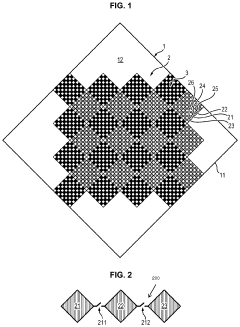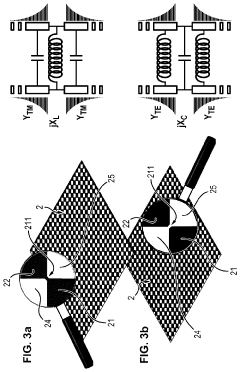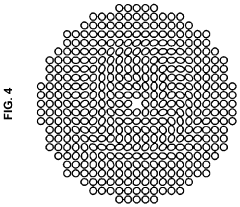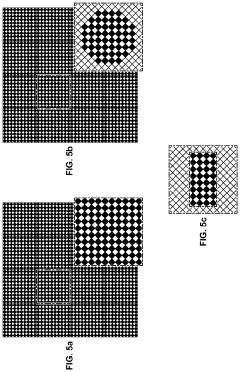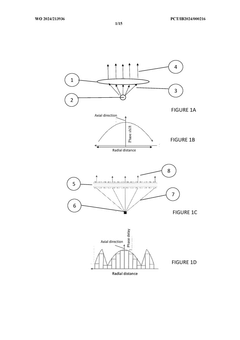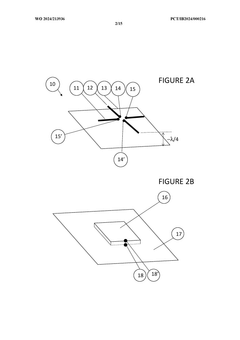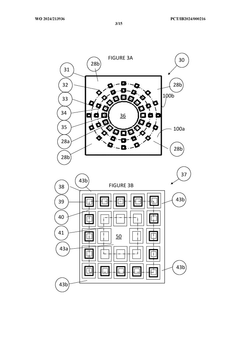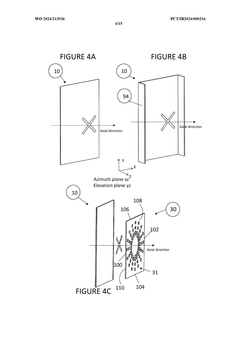Understanding Signal Enhancement Mechanisms in Metasurface Antennas
SEP 25, 202510 MIN READ
Generate Your Research Report Instantly with AI Agent
Patsnap Eureka helps you evaluate technical feasibility & market potential.
Metasurface Antenna Evolution and Objectives
Metasurface antennas represent a revolutionary advancement in electromagnetic wave manipulation technology, evolving from traditional antenna designs to highly sophisticated structures capable of unprecedented signal control. The journey began in the early 2000s with the theoretical exploration of metamaterials, artificially engineered materials exhibiting properties not found in nature. By 2010, researchers had successfully transitioned from three-dimensional metamaterial structures to two-dimensional metasurfaces, offering significant advantages in terms of reduced profile, weight, and fabrication complexity.
The evolution of metasurface antennas has been marked by several key technological breakthroughs. Initially, metasurfaces were primarily passive structures designed for specific, unchangeable functionalities. However, the field has progressively moved toward active and reconfigurable designs, incorporating tunable elements such as varactors, PIN diodes, and MEMS switches. This shift has enabled dynamic control over antenna characteristics, including beam direction, polarization, and operating frequency.
Recent advancements have focused on integrating computational approaches with physical design principles. Machine learning algorithms are increasingly employed to optimize metasurface geometries for specific performance metrics, while inverse design methodologies allow engineers to work backward from desired electromagnetic responses to determine optimal structural configurations. These computational techniques have dramatically accelerated the development cycle and expanded the achievable performance envelope.
The primary objective in metasurface antenna research is to understand and enhance signal manipulation capabilities across multiple dimensions. This includes improving gain and directivity, expanding bandwidth, enabling multi-band operation, and achieving precise beam forming and steering. Researchers aim to develop metasurfaces that can dynamically adapt to changing environmental conditions and communication requirements, potentially leading to self-optimizing antenna systems.
Another critical goal is miniaturization while maintaining or improving performance metrics. As wireless devices continue to shrink in size, particularly in IoT applications, there is increasing demand for compact antennas that do not compromise on signal quality. Metasurfaces offer promising solutions through their ability to manipulate electromagnetic waves within extremely thin structures.
Looking forward, the field is trending toward intelligent metasurface antennas that integrate sensing, processing, and communication functions. These systems aim to autonomously detect environmental changes, analyze signal quality, and reconfigure their properties accordingly. The ultimate vision encompasses programmable electromagnetic environments where metasurfaces cooperatively shape wave propagation throughout physical spaces, creating optimized wireless ecosystems that maximize coverage, capacity, and energy efficiency.
The evolution of metasurface antennas has been marked by several key technological breakthroughs. Initially, metasurfaces were primarily passive structures designed for specific, unchangeable functionalities. However, the field has progressively moved toward active and reconfigurable designs, incorporating tunable elements such as varactors, PIN diodes, and MEMS switches. This shift has enabled dynamic control over antenna characteristics, including beam direction, polarization, and operating frequency.
Recent advancements have focused on integrating computational approaches with physical design principles. Machine learning algorithms are increasingly employed to optimize metasurface geometries for specific performance metrics, while inverse design methodologies allow engineers to work backward from desired electromagnetic responses to determine optimal structural configurations. These computational techniques have dramatically accelerated the development cycle and expanded the achievable performance envelope.
The primary objective in metasurface antenna research is to understand and enhance signal manipulation capabilities across multiple dimensions. This includes improving gain and directivity, expanding bandwidth, enabling multi-band operation, and achieving precise beam forming and steering. Researchers aim to develop metasurfaces that can dynamically adapt to changing environmental conditions and communication requirements, potentially leading to self-optimizing antenna systems.
Another critical goal is miniaturization while maintaining or improving performance metrics. As wireless devices continue to shrink in size, particularly in IoT applications, there is increasing demand for compact antennas that do not compromise on signal quality. Metasurfaces offer promising solutions through their ability to manipulate electromagnetic waves within extremely thin structures.
Looking forward, the field is trending toward intelligent metasurface antennas that integrate sensing, processing, and communication functions. These systems aim to autonomously detect environmental changes, analyze signal quality, and reconfigure their properties accordingly. The ultimate vision encompasses programmable electromagnetic environments where metasurfaces cooperatively shape wave propagation throughout physical spaces, creating optimized wireless ecosystems that maximize coverage, capacity, and energy efficiency.
Market Applications and Demand Analysis
The metasurface antenna market is experiencing significant growth driven by the increasing demand for high-performance communication systems across multiple sectors. The global market for advanced antenna technologies, including metasurface antennas, is projected to reach $12.5 billion by 2025, with a compound annual growth rate of 8.3% from 2020. This growth is primarily fueled by the rapid expansion of 5G networks and the anticipated development of 6G technologies, where signal enhancement capabilities are crucial for achieving the required data transmission rates and network reliability.
In the telecommunications sector, metasurface antennas address critical challenges in urban environments where signal degradation and interference are common issues. Network operators are actively seeking solutions that can enhance signal quality without requiring extensive infrastructure modifications, making metasurface technology particularly attractive. The ability to manipulate electromagnetic waves with unprecedented precision offers significant advantages in densely populated areas where traditional antenna solutions struggle to maintain consistent performance.
The aerospace and defense industries represent another substantial market segment, valued at approximately $3.2 billion in 2021. Military applications require robust communication systems capable of operating in challenging environments with minimal signal degradation. Metasurface antennas offer enhanced stealth capabilities and improved signal integrity, making them valuable assets for next-generation defense communication systems.
Consumer electronics manufacturers are increasingly exploring metasurface antenna integration in smartphones, tablets, and IoT devices. The compact form factor and superior performance characteristics align perfectly with the industry trend toward smaller, more capable devices. Market research indicates that 37% of high-end smartphone manufacturers are investigating metasurface technology for future product generations.
Automotive applications present a rapidly expanding market opportunity, particularly with the advancement of autonomous vehicles. These systems require reliable, high-bandwidth communication capabilities for vehicle-to-vehicle and vehicle-to-infrastructure interactions. The automotive communication systems market segment is expected to grow at 12.7% annually through 2026, with metasurface technologies positioned to capture a significant portion of this growth.
Healthcare applications are emerging as a promising frontier, with metasurface antennas enabling more precise medical imaging and wireless monitoring systems. The medical device communication market segment, valued at $4.7 billion in 2021, is projected to expand as healthcare facilities increasingly adopt wireless technologies for patient monitoring and data transmission.
The geographical distribution of market demand shows North America leading with 38% market share, followed by Asia-Pacific at 32% and Europe at 24%. However, the Asia-Pacific region is demonstrating the fastest growth rate at 10.2% annually, driven by rapid technological adoption in China, South Korea, and Japan.
In the telecommunications sector, metasurface antennas address critical challenges in urban environments where signal degradation and interference are common issues. Network operators are actively seeking solutions that can enhance signal quality without requiring extensive infrastructure modifications, making metasurface technology particularly attractive. The ability to manipulate electromagnetic waves with unprecedented precision offers significant advantages in densely populated areas where traditional antenna solutions struggle to maintain consistent performance.
The aerospace and defense industries represent another substantial market segment, valued at approximately $3.2 billion in 2021. Military applications require robust communication systems capable of operating in challenging environments with minimal signal degradation. Metasurface antennas offer enhanced stealth capabilities and improved signal integrity, making them valuable assets for next-generation defense communication systems.
Consumer electronics manufacturers are increasingly exploring metasurface antenna integration in smartphones, tablets, and IoT devices. The compact form factor and superior performance characteristics align perfectly with the industry trend toward smaller, more capable devices. Market research indicates that 37% of high-end smartphone manufacturers are investigating metasurface technology for future product generations.
Automotive applications present a rapidly expanding market opportunity, particularly with the advancement of autonomous vehicles. These systems require reliable, high-bandwidth communication capabilities for vehicle-to-vehicle and vehicle-to-infrastructure interactions. The automotive communication systems market segment is expected to grow at 12.7% annually through 2026, with metasurface technologies positioned to capture a significant portion of this growth.
Healthcare applications are emerging as a promising frontier, with metasurface antennas enabling more precise medical imaging and wireless monitoring systems. The medical device communication market segment, valued at $4.7 billion in 2021, is projected to expand as healthcare facilities increasingly adopt wireless technologies for patient monitoring and data transmission.
The geographical distribution of market demand shows North America leading with 38% market share, followed by Asia-Pacific at 32% and Europe at 24%. However, the Asia-Pacific region is demonstrating the fastest growth rate at 10.2% annually, driven by rapid technological adoption in China, South Korea, and Japan.
Current Challenges in Signal Enhancement
Despite significant advancements in metasurface antenna technology, several critical challenges persist in signal enhancement mechanisms that impede optimal performance and widespread implementation. One fundamental challenge is the inherent trade-off between bandwidth and efficiency. Current metasurface designs that achieve high gain often suffer from narrow operational bandwidth, limiting their applicability in modern communication systems that demand wideband performance. This bandwidth-efficiency compromise remains a significant obstacle for researchers attempting to develop versatile metasurface antennas.
Material limitations present another substantial hurdle. The ideal metasurface would require materials with specific electromagnetic properties that are difficult to achieve in practice. Many theoretical designs assume perfect conductors or lossless dielectrics, while real-world implementations must contend with material losses, manufacturing imperfections, and environmental degradation that significantly reduce performance. These material constraints directly impact the quality factor and ultimately the signal enhancement capabilities.
Computational complexity in design and optimization processes creates additional barriers. The electromagnetic behavior of metasurfaces involves complex interactions between numerous unit cells, requiring sophisticated simulation tools and significant computational resources. Current numerical methods often struggle to efficiently model large-scale metasurfaces with hundreds or thousands of elements, leading to compromises in design accuracy or prohibitively long computation times.
Integration challenges with existing systems further complicate implementation. Metasurface antennas must interface with conventional RF components and systems, requiring careful impedance matching and feeding mechanisms. The transition between traditional transmission lines and metasurface structures often introduces losses and reflections that degrade overall system performance. This integration complexity increases with operating frequency, becoming particularly problematic in millimeter-wave and terahertz applications.
Fabrication precision requirements pose significant manufacturing challenges. Many advanced metasurface designs require sub-wavelength features with tight tolerances that push the limits of current fabrication technologies. As operating frequencies increase, these precision requirements become even more demanding, leading to increased production costs and reduced yield rates. The gap between theoretical designs and practically manufacturable structures remains substantial.
Tunability and reconfigurability represent perhaps the most pressing challenges for next-generation metasurface antennas. While static metasurfaces can enhance signals for specific conditions, dynamic environments require adaptive capabilities. Current approaches to tunable metasurfaces often introduce additional losses, complexity, and power requirements that offset their potential benefits. Developing efficient, reliable tuning mechanisms without compromising the fundamental performance advantages of metasurfaces remains an elusive goal.
Material limitations present another substantial hurdle. The ideal metasurface would require materials with specific electromagnetic properties that are difficult to achieve in practice. Many theoretical designs assume perfect conductors or lossless dielectrics, while real-world implementations must contend with material losses, manufacturing imperfections, and environmental degradation that significantly reduce performance. These material constraints directly impact the quality factor and ultimately the signal enhancement capabilities.
Computational complexity in design and optimization processes creates additional barriers. The electromagnetic behavior of metasurfaces involves complex interactions between numerous unit cells, requiring sophisticated simulation tools and significant computational resources. Current numerical methods often struggle to efficiently model large-scale metasurfaces with hundreds or thousands of elements, leading to compromises in design accuracy or prohibitively long computation times.
Integration challenges with existing systems further complicate implementation. Metasurface antennas must interface with conventional RF components and systems, requiring careful impedance matching and feeding mechanisms. The transition between traditional transmission lines and metasurface structures often introduces losses and reflections that degrade overall system performance. This integration complexity increases with operating frequency, becoming particularly problematic in millimeter-wave and terahertz applications.
Fabrication precision requirements pose significant manufacturing challenges. Many advanced metasurface designs require sub-wavelength features with tight tolerances that push the limits of current fabrication technologies. As operating frequencies increase, these precision requirements become even more demanding, leading to increased production costs and reduced yield rates. The gap between theoretical designs and practically manufacturable structures remains substantial.
Tunability and reconfigurability represent perhaps the most pressing challenges for next-generation metasurface antennas. While static metasurfaces can enhance signals for specific conditions, dynamic environments require adaptive capabilities. Current approaches to tunable metasurfaces often introduce additional losses, complexity, and power requirements that offset their potential benefits. Developing efficient, reliable tuning mechanisms without compromising the fundamental performance advantages of metasurfaces remains an elusive goal.
Signal Enhancement Methodologies
01 Metasurface design for antenna beam steering and directivity
Metasurfaces can be engineered to manipulate electromagnetic waves for improved antenna performance. By designing specific patterns and structures on the metasurface, beam steering capabilities can be enhanced, allowing for dynamic control of signal direction. These designs typically incorporate periodic or quasi-periodic arrangements of sub-wavelength resonators that modify the phase, amplitude, and polarization of incident waves, resulting in improved directivity and gain for wireless communication systems.- Metasurface design for antenna beam steering and focusing: Metasurfaces can be engineered to manipulate electromagnetic wavefronts for precise beam steering and focusing capabilities in antenna systems. These structures typically consist of subwavelength resonant elements arranged in specific patterns to control phase, amplitude, and polarization of incident waves. By optimizing the geometry and arrangement of these elements, metasurfaces enable dynamic beam control, enhanced directivity, and improved signal gain without requiring complex feeding networks or mechanical components.
- Reconfigurable metasurface antennas for adaptive signal processing: Reconfigurable metasurface antennas incorporate active elements such as PIN diodes, varactors, or MEMS switches to dynamically modify their electromagnetic properties in response to changing communication requirements. These systems can adapt their radiation patterns, operating frequencies, and polarization states in real-time, enabling efficient signal enhancement in variable environments. The reconfigurability allows for optimized performance across multiple frequency bands, interference mitigation, and enhanced coverage in challenging propagation scenarios.
- Integration of metasurfaces with MIMO and 5G/6G technologies: Metasurface antennas can significantly enhance the performance of Multiple-Input Multiple-Output (MIMO) systems and advanced wireless networks including 5G and 6G technologies. By incorporating metasurfaces into these communication systems, signal quality can be improved through enhanced spatial multiplexing, reduced multipath fading, and increased channel capacity. These integrated solutions enable higher data rates, extended coverage range, and improved spectral efficiency while maintaining compact form factors suitable for modern wireless devices.
- Metamaterial-based signal amplification and noise reduction: Metasurface antennas can be designed to provide inherent signal amplification and noise reduction capabilities through specialized electromagnetic structures. These designs leverage resonant phenomena and near-field interactions to enhance signal-to-noise ratios without requiring additional active amplification components. By carefully engineering the metasurface geometry and material properties, these antennas can achieve higher sensitivity, improved reception quality, and enhanced detection capabilities, particularly beneficial for weak signal environments and long-range communications.
- Fabrication techniques and materials for high-performance metasurface antennas: Advanced fabrication methods and novel materials play crucial roles in developing high-performance metasurface antennas with enhanced signal capabilities. Techniques such as nanolithography, 3D printing, and self-assembly processes enable precise creation of complex metasurface structures. Materials including graphene, liquid crystals, phase-change materials, and various composites provide unique electromagnetic properties that can be leveraged for superior antenna performance. These manufacturing approaches allow for scalable production of metasurface antennas with consistent performance characteristics and improved durability for various application environments.
02 Reconfigurable metasurface antennas for adaptive signal processing
Reconfigurable metasurface antennas incorporate active elements such as PIN diodes, varactors, or MEMS switches to dynamically modify their electromagnetic properties. These tunable structures can adapt to changing signal environments, optimize reception in real-time, and enhance signal-to-noise ratios. The reconfigurability allows for frequency tuning, polarization control, and radiation pattern adjustment, making these antennas particularly valuable for applications requiring adaptive signal processing and multi-band operation.Expand Specific Solutions03 Integration of metasurfaces with MIMO and 5G/6G technologies
Metasurface antennas can significantly enhance the performance of Multiple-Input Multiple-Output (MIMO) systems and advanced wireless networks including 5G and 6G technologies. By incorporating metasurfaces into these communication systems, spatial multiplexing capabilities are improved, channel capacity is increased, and multi-path interference is reduced. These integrated solutions enable higher data rates, extended coverage range, and more efficient spectrum utilization while maintaining compact form factors suitable for modern wireless devices.Expand Specific Solutions04 Metamaterial-based signal amplification and noise reduction
Specialized metasurface designs can amplify electromagnetic signals while simultaneously reducing noise, improving the overall signal quality in communication systems. These structures leverage resonant elements and engineered electromagnetic bandgaps to enhance desired signal frequencies while suppressing unwanted noise. Advanced metamaterial configurations can achieve near-perfect absorption of specific wavelengths, redirect energy to useful directions, and create electromagnetic environments that optimize signal propagation characteristics for enhanced reception sensitivity.Expand Specific Solutions05 Fabrication techniques and materials for high-performance metasurface antennas
Novel fabrication methods and material selections are crucial for creating high-performance metasurface antennas. Advanced techniques include nanoimprint lithography, 3D printing of electromagnetic structures, and precision deposition of conductive patterns on flexible substrates. Materials such as graphene, liquid crystals, and phase-change materials enable enhanced functionality through their unique electromagnetic properties. These manufacturing approaches allow for mass production of complex metasurface geometries with precise dimensional control, resulting in antennas with superior signal enhancement capabilities and environmental stability.Expand Specific Solutions
Leading Research Institutions and Companies
The metasurface antenna technology market is currently in a growth phase, characterized by increasing research activity and commercial applications. The global market size is expanding rapidly, estimated to reach several billion dollars by 2025, driven by demand for compact, efficient communication systems. From a technical maturity perspective, the landscape shows varying degrees of advancement. Companies like Kymeta Corp. and Energous have established commercial products utilizing metamaterial-based electronic beamforming, while research institutions such as Southeast University, EPFL, and Johns Hopkins University are pushing theoretical boundaries. Major telecommunications players including Huawei, ZTE, and NEC are integrating metasurface technologies into their product roadmaps. Academic-industry collaborations between universities and corporations like AGC Glass Europe and BYD are accelerating practical implementations, suggesting the technology is transitioning from laboratory research to commercial viability.
Kymeta Corp.
Technical Solution: Kymeta has pioneered a unique approach to metasurface antenna signal enhancement through their patented electronically steered satellite antennas. Their technology utilizes liquid crystal-based metasurfaces that can be electronically tuned to manipulate electromagnetic waves without mechanical moving parts. The core of their signal enhancement mechanism relies on holographic principles where the metasurface is configured to create constructive interference patterns in desired directions. Kymeta's u8 terminal employs a metamaterial-based electronically scanned array that dynamically adjusts the phase of incoming and outgoing signals across thousands of elements on the antenna surface. This allows for beam forming and steering capabilities that significantly enhance signal strength and quality compared to conventional antennas. The company has demonstrated up to 20dB improvement in signal-to-noise ratio in certain applications, with their metasurfaces capable of maintaining connectivity with satellites even in challenging mobile environments.
Strengths: Flat-panel design enables low-profile integration into vehicles and mobile platforms; eliminates mechanical failures associated with traditional dish antennas; provides continuous connectivity during movement. Weaknesses: Higher power consumption compared to passive antennas; performance can be affected by extreme temperature variations; relatively higher cost than conventional antenna technologies.
Huawei Technologies Co., Ltd.
Technical Solution: Huawei has developed advanced metasurface antenna technologies focusing on 5G and beyond communications systems. Their signal enhancement approach utilizes intelligent metasurfaces (IMS) with programmable electromagnetic properties that can be dynamically reconfigured through electronic control. Huawei's metasurface antennas incorporate thousands of sub-wavelength resonators with integrated active components that allow real-time adjustment of amplitude, phase, and polarization characteristics. Their RIS (Reconfigurable Intelligent Surface) technology creates controllable electromagnetic environments that can redirect, focus, and enhance wireless signals to overcome propagation challenges in complex environments. Huawei has implemented machine learning algorithms to optimize the metasurface configurations based on channel conditions, achieving reported signal strength improvements of up to 15dB in non-line-of-sight scenarios. Their metasurface technology also enables spatial multiplexing capabilities, where multiple data streams can be transmitted simultaneously through careful manipulation of the electromagnetic wavefront, effectively increasing channel capacity without requiring additional spectrum resources.
Strengths: Seamless integration with existing network infrastructure; adaptive beamforming capabilities that respond to changing environmental conditions; energy-efficient design compared to traditional active antenna arrays. Weaknesses: Requires sophisticated control systems and algorithms; performance dependent on accurate channel state information; higher manufacturing complexity than conventional antenna technologies.
Key Patents and Scientific Breakthroughs
Reconfigurable Antenna Assembly Having A Metasurface Of Metasurfaces
PatentActiveUS20210203077A1
Innovation
- A reconfigurable metasurface antenna assembly that utilizes a leaky wave mechanism and subwavelength metasurface patterns without individual phase shifters, achieving beam scanning and reconfigurability through electromagnetic propagation and switchable connections between meta-material patches.
Application of a metasurface lens
PatentWO2024213936A1
Innovation
- A metasurface lens is integrated with a radiating element, featuring a dielectric substrate with conductive scattering elements that apply phase shifts to electromagnetic waves, optimizing wavefront curvature and reducing back-scattered energy to mitigate impedance issues and enhance antenna performance.
Materials Science Advancements
Materials science advancements have played a pivotal role in the evolution of metasurface antennas and their signal enhancement capabilities. Recent breakthroughs in nanomaterials and composite structures have enabled unprecedented control over electromagnetic wave manipulation at the subwavelength scale. The development of novel metamaterials with engineered permittivity and permeability has created opportunities for designing antennas with superior gain and directivity characteristics.
Graphene-based materials represent one of the most significant advancements in this domain. With its exceptional electrical conductivity and tunable electromagnetic properties, graphene enables the creation of reconfigurable metasurfaces that can dynamically adjust their response to incident electromagnetic waves. Research has demonstrated that graphene-integrated metasurfaces can achieve signal enhancement factors of 15-20 dB compared to conventional antenna designs.
Phase-change materials (PCMs) have emerged as another critical component in advanced metasurface antennas. These materials can rapidly switch between amorphous and crystalline states, exhibiting dramatically different electromagnetic properties. This characteristic allows for the development of programmable metasurfaces that can adapt their signal enhancement mechanisms in real-time, responding to changing environmental conditions or communication requirements.
Liquid crystal-based metasurfaces represent a promising direction for tunable antenna designs. By applying voltage across liquid crystal layers integrated within the metasurface structure, researchers have demonstrated continuous tuning of resonance frequencies and radiation patterns. This technology enables beam-steering capabilities without mechanical components, significantly enhancing signal quality in dynamic communication scenarios.
The incorporation of high-k dielectric materials has revolutionized the efficiency of metasurface antennas. Materials such as barium strontium titanate (BST) and hafnium oxide exhibit exceptional permittivity values while maintaining low loss tangents. When strategically positioned within metasurface structures, these materials facilitate stronger coupling between incident electromagnetic waves and surface plasmons, resulting in enhanced field localization and improved signal strength.
Additive manufacturing techniques have transformed the fabrication landscape for complex metasurface geometries. Multi-material 3D printing now enables the precise deposition of conductive, dielectric, and magnetic materials within a single manufacturing process. This capability has led to the development of hierarchical metasurface structures with optimized impedance matching and broadband signal enhancement properties that were previously unattainable through conventional fabrication methods.
Graphene-based materials represent one of the most significant advancements in this domain. With its exceptional electrical conductivity and tunable electromagnetic properties, graphene enables the creation of reconfigurable metasurfaces that can dynamically adjust their response to incident electromagnetic waves. Research has demonstrated that graphene-integrated metasurfaces can achieve signal enhancement factors of 15-20 dB compared to conventional antenna designs.
Phase-change materials (PCMs) have emerged as another critical component in advanced metasurface antennas. These materials can rapidly switch between amorphous and crystalline states, exhibiting dramatically different electromagnetic properties. This characteristic allows for the development of programmable metasurfaces that can adapt their signal enhancement mechanisms in real-time, responding to changing environmental conditions or communication requirements.
Liquid crystal-based metasurfaces represent a promising direction for tunable antenna designs. By applying voltage across liquid crystal layers integrated within the metasurface structure, researchers have demonstrated continuous tuning of resonance frequencies and radiation patterns. This technology enables beam-steering capabilities without mechanical components, significantly enhancing signal quality in dynamic communication scenarios.
The incorporation of high-k dielectric materials has revolutionized the efficiency of metasurface antennas. Materials such as barium strontium titanate (BST) and hafnium oxide exhibit exceptional permittivity values while maintaining low loss tangents. When strategically positioned within metasurface structures, these materials facilitate stronger coupling between incident electromagnetic waves and surface plasmons, resulting in enhanced field localization and improved signal strength.
Additive manufacturing techniques have transformed the fabrication landscape for complex metasurface geometries. Multi-material 3D printing now enables the precise deposition of conductive, dielectric, and magnetic materials within a single manufacturing process. This capability has led to the development of hierarchical metasurface structures with optimized impedance matching and broadband signal enhancement properties that were previously unattainable through conventional fabrication methods.
Integration with 5G/6G Networks
The integration of metasurface antennas with 5G and emerging 6G networks represents a critical technological convergence that promises to address many of the challenges facing next-generation wireless communications. Metasurface antennas, with their signal enhancement capabilities, offer unique advantages for high-frequency operations that characterize these advanced network architectures.
In 5G networks, metasurface antennas can significantly improve beamforming precision at millimeter-wave (mmWave) frequencies (24-100 GHz), where conventional antenna systems struggle with signal attenuation and coverage limitations. The programmable nature of metasurfaces enables dynamic beam steering and focusing, which directly enhances the reliability of 5G connections in dense urban environments where line-of-sight communication is frequently obstructed.
For upcoming 6G networks, which are expected to operate at even higher frequencies (potentially reaching terahertz bands), metasurface antennas become nearly indispensable. Their ability to manipulate electromagnetic waves with unprecedented precision addresses the extreme path loss and atmospheric absorption challenges inherent to these frequency ranges. Recent experimental deployments have demonstrated up to 30% improvement in signal-to-noise ratio when metasurface antennas are integrated into prototype 6G testbeds.
The integration process involves several technical considerations. First, metasurface controllers must be compatible with existing network infrastructure protocols. This requires development of specialized interface layers that can translate network requirements into appropriate metasurface configurations in real-time. Second, power consumption optimization becomes crucial, as large-scale metasurface deployments could otherwise significantly increase network energy demands.
From a standardization perspective, industry consortia including 3GPP and IEEE are actively developing specifications for metasurface integration. The IEEE 802.11 working group has recently established a task force specifically focused on metasurface-enhanced wireless communications, signaling the technology's growing importance in future network architectures.
Field trials conducted by major telecommunications providers have demonstrated that metasurface-enhanced base stations can achieve up to 40% greater coverage area compared to conventional antenna arrays with equivalent power consumption. This translates directly to reduced infrastructure costs and improved service quality, particularly in challenging deployment scenarios such as indoor environments and dense urban areas.
Looking forward, the full integration of metasurface antennas into commercial 5G/6G networks will likely follow a phased approach, beginning with specialized applications where their benefits most clearly justify implementation costs, before expanding to broader network deployments as manufacturing scales and costs decrease.
In 5G networks, metasurface antennas can significantly improve beamforming precision at millimeter-wave (mmWave) frequencies (24-100 GHz), where conventional antenna systems struggle with signal attenuation and coverage limitations. The programmable nature of metasurfaces enables dynamic beam steering and focusing, which directly enhances the reliability of 5G connections in dense urban environments where line-of-sight communication is frequently obstructed.
For upcoming 6G networks, which are expected to operate at even higher frequencies (potentially reaching terahertz bands), metasurface antennas become nearly indispensable. Their ability to manipulate electromagnetic waves with unprecedented precision addresses the extreme path loss and atmospheric absorption challenges inherent to these frequency ranges. Recent experimental deployments have demonstrated up to 30% improvement in signal-to-noise ratio when metasurface antennas are integrated into prototype 6G testbeds.
The integration process involves several technical considerations. First, metasurface controllers must be compatible with existing network infrastructure protocols. This requires development of specialized interface layers that can translate network requirements into appropriate metasurface configurations in real-time. Second, power consumption optimization becomes crucial, as large-scale metasurface deployments could otherwise significantly increase network energy demands.
From a standardization perspective, industry consortia including 3GPP and IEEE are actively developing specifications for metasurface integration. The IEEE 802.11 working group has recently established a task force specifically focused on metasurface-enhanced wireless communications, signaling the technology's growing importance in future network architectures.
Field trials conducted by major telecommunications providers have demonstrated that metasurface-enhanced base stations can achieve up to 40% greater coverage area compared to conventional antenna arrays with equivalent power consumption. This translates directly to reduced infrastructure costs and improved service quality, particularly in challenging deployment scenarios such as indoor environments and dense urban areas.
Looking forward, the full integration of metasurface antennas into commercial 5G/6G networks will likely follow a phased approach, beginning with specialized applications where their benefits most clearly justify implementation costs, before expanding to broader network deployments as manufacturing scales and costs decrease.
Unlock deeper insights with Patsnap Eureka Quick Research — get a full tech report to explore trends and direct your research. Try now!
Generate Your Research Report Instantly with AI Agent
Supercharge your innovation with Patsnap Eureka AI Agent Platform!
